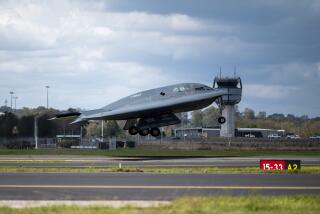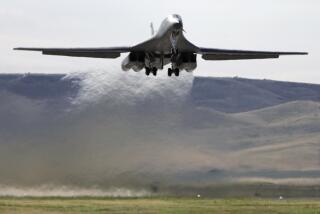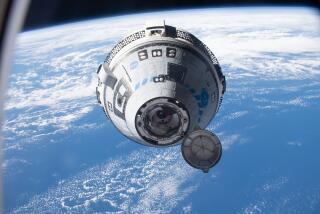Northrop’s Stealth Bomber Marks a Crucial Milestone
- Share via
Northrop fired up the B-2 stealth bomber’s engines for first time late Thursday night in Palmdale, a technically important, if long overdue, milestone in the controversial and costly aircraft program, it was learned Friday.
The engine test is an important step toward the first flight of the new bomber, a so-called flying wing that lacks a conventional fuselage. The first flight is already about a year and a half behind the original schedule and some four months past the date set by the Air Force only last November.
Four Engines Started
Aeronautics experts said Northrop will need a minimum of another 30 days to complete engine testing, if everything goes perfectly, before attempting flight. Owing to the craft’s radical design, some skeptics say it may not be airworthy.
The nuclear bomber’s four General Electric F-118 jet engines, which each generate about 19,000 pounds of thrust, were started inside a large engine test facility, according to employees. Later, Northrop officially confirmed that the test had been conducted.
Another industry source said, “All four engines ran, and things went well.”
The critical test had been repeatedly delayed in recent days and on Thursday had been scheduled for early and then late afternoon, the sources said. Finally, they added, engineers started the engines late Thursday.
Congress has been scrutinizing each delay in the bomber program, and the successful test is encouraging at a critical time for Northrop.
The B-2 cost has been spiraling upward rapidly. Only last week, Air Force Chief Gen. Larry C. Welch said that, because of delays caused by budget constraints, the cost had jumped another $3 billion to about $74 billion to build 132 of the planes--$560 million each.
But congressional sources say that even the $74-billion figure is based on “highly optimistic” assumptions that everything will go perfectly in the testing and production program. Numbers as high as $650 million to $700 million per aircraft are being considered as more realistic estimates.
For example, the $74-billion cost estimate assumes that the research and development cost will not increase further than it already has. It also assumes that the Pentagon will have “significant budget resources” to devote to rapid B-2 production, meaning more than $4 billion annually.
A Northrop spokesman said Friday that bombers will cost $265 million each, not including the development costs and future inflation that are part of the higher cost estimates being quoted by the Air Force. “If you reduce the production rate, the cost goes up,” Tony Cantafio said. “You could call it pay-as-you-slow.”
Robert Costello, undersecretary of defense for acquisition, said in an interview Thursday that, as the cost of the B-2 approaches $700 million each, it begins to look unaffordable. He confirmed assertions by Rep. Les Aspin (D-Wis.) that the cost of the program is headed toward $75 billion.
“That’s as good a figure as I’ve seen to date, but it may go higher,” Costello, a holdover from the Reagan Administration who left his job Friday, said. “The role of this office is to say at some point, ‘Hey, boss, is it too expensive?’ I’ve just raised the warning flag.”
Deciding on Cuts
The cost increases are driven by two factors: technical problems and budget shortages, both of which cause delays. Each delay drives up the cost of the overall program, which threatens a cutback in the rate of production. In turn, the rate cutbacks drive up the cost per aircraft, leading to a vicious circle of escalating costs.
Congressional committees will be marking up the fiscal 1990 budgets next month and will decide how large a cut to make in the B-2 budget.
Defense Secretary Dick Cheney submitted a budget last month that cut the program by $885 million in 1990 and $3.2 billion in 1991. Although he did not disclose current funding, the sharp reductions mean that the program will not go into full-scale production.
In recent weeks, the Air Force has moved to offset criticism of the bomber by increasingly declassifying its technical capabilities while continuing to keep secret the budget details.
Air Force Gen. Bernard P. Randolph said the B-2 will be capable of carrying a nuclear or conventional payload of 50,000 pounds. He said it has a range of 6,000 nautical miles at high altitude without refueling.
Times staff writer John M. Broder in Washington contributed to this story.
More to Read
Inside the business of entertainment
The Wide Shot brings you news, analysis and insights on everything from streaming wars to production — and what it all means for the future.
You may occasionally receive promotional content from the Los Angeles Times.











